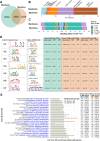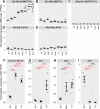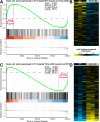Six1 promotes skeletal muscle thyroid hormone response through regulation of the MCT10 transporter
- PMID: 34809717
- PMCID: PMC8607597
- DOI: 10.1186/s13395-021-00281-6
Six1 promotes skeletal muscle thyroid hormone response through regulation of the MCT10 transporter
Abstract
Background: The Six1 transcription factor is implicated in controlling the development of several tissue types, notably skeletal muscle. Six1 also contributes to muscle metabolism and its activity is associated with the fast-twitch, glycolytic phenotype. Six1 regulates the expression of certain genes of the fast muscle program by directly stimulating their transcription or indirectly acting through a long non-coding RNA. We hypothesized that additional mechanisms of action of Six1 might be at play.
Methods: A combined analysis of gene expression profiling and genome-wide location analysis data was performed. Results were validated using in vivo RNA interference loss-of-function assays followed by measurement of gene expression by RT-PCR and transcriptional reporter assays.
Results: The Slc16a10 gene, encoding the thyroid hormone transmembrane transporter MCT10, was identified as a gene with a transcriptional enhancer directly bound by Six1 and requiring Six1 activity for full expression in adult mouse tibialis anterior, a predominantly fast-twitch muscle. Of the various thyroid hormone transporters, MCT10 mRNA was found to be the most abundant in skeletal muscle, and to have a stronger expression in fast-twitch compared to slow-twitch muscle groups. Loss-of-function of MCT10 in the tibialis anterior recapitulated the effect of Six1 on the expression of fast-twitch muscle genes and led to lower activity of a thyroid hormone receptor-dependent reporter gene.
Conclusions: These results shed light on the molecular mechanisms controlling the tissue expression profile of MCT10 and identify modulation of the thyroid hormone signaling pathway as an additional mechanism by which Six1 influences skeletal muscle metabolism.
© 2021. The Author(s).
Conflict of interest statement
The authors declare that they have no competing interests.
Figures








Similar articles
-
Six1 and Eya1 expression can reprogram adult muscle from the slow-twitch phenotype into the fast-twitch phenotype.Mol Cell Biol. 2004 Jul;24(14):6253-67. doi: 10.1128/MCB.24.14.6253-6267.2004. Mol Cell Biol. 2004. PMID: 15226428 Free PMC article.
-
Genesis of muscle fiber-type diversity during mouse embryogenesis relies on Six1 and Six4 gene expression.Dev Biol. 2011 Nov 15;359(2):303-20. doi: 10.1016/j.ydbio.2011.08.010. Epub 2011 Aug 22. Dev Biol. 2011. PMID: 21884692
-
Six1 regulates MyoD expression in adult muscle progenitor cells.PLoS One. 2013 Jun 28;8(6):e67762. doi: 10.1371/journal.pone.0067762. Print 2013. PLoS One. 2013. PMID: 23840772 Free PMC article.
-
The role of Six1 in the genesis of muscle cell and skeletal muscle development.Int J Biol Sci. 2014 Sep 5;10(9):983-9. doi: 10.7150/ijbs.9442. eCollection 2014. Int J Biol Sci. 2014. PMID: 25210496 Free PMC article. Review.
-
Minireview: Pathophysiological importance of thyroid hormone transporters.Endocrinology. 2009 Mar;150(3):1078-83. doi: 10.1210/en.2008-1518. Epub 2009 Jan 29. Endocrinology. 2009. PMID: 19179441 Review.
Cited by
-
Overlapping functions of SIX homeoproteins during embryonic myogenesis.PLoS Genet. 2023 Jun 2;19(6):e1010781. doi: 10.1371/journal.pgen.1010781. eCollection 2023 Jun. PLoS Genet. 2023. PMID: 37267426 Free PMC article.
-
Human Body Single-Cell Atlas of 3D Genome Organization and DNA Methylation.bioRxiv [Preprint]. 2025 Mar 24:2025.03.23.644697. doi: 10.1101/2025.03.23.644697. bioRxiv. 2025. PMID: 40196612 Free PMC article. Preprint.
-
Developmental, physiologic and phylogenetic perspectives on the expression and regulation of myosin heavy chains in mammalian skeletal muscles.J Comp Physiol B. 2023 Aug;193(4):355-382. doi: 10.1007/s00360-023-01499-0. Epub 2023 Jun 5. J Comp Physiol B. 2023. PMID: 37277594 Free PMC article. Review.
-
Study on gene expression in stomach at different developmental stages of human embryos.Front Cell Dev Biol. 2025 May 30;13:1564789. doi: 10.3389/fcell.2025.1564789. eCollection 2025. Front Cell Dev Biol. 2025. PMID: 40519260 Free PMC article.
References
-
- Kawakami K, Ohto H, Takizawa T, Saito T. Identification and expression of six family genes in mouse retina. FEBS Lett. 1996;393(2–3):259–263. - PubMed
-
- Kawakami K, Sato S, Ozaki H, Ikeda K. Six family genes–structure and function as transcription factors and their roles in development. BioEssays News Rev Mol Cell Dev Biol. 2000;22(7):616–626. - PubMed
-
- Bebenek IG, Gates RD, Morris J, Hartenstein V, Jacobs DK. sine oculis in basal Metazoa. Dev Genes Evol. 2004;214(7):342–351. - PubMed
Publication types
MeSH terms
Substances
Grants and funding
LinkOut - more resources
Full Text Sources
Molecular Biology Databases

